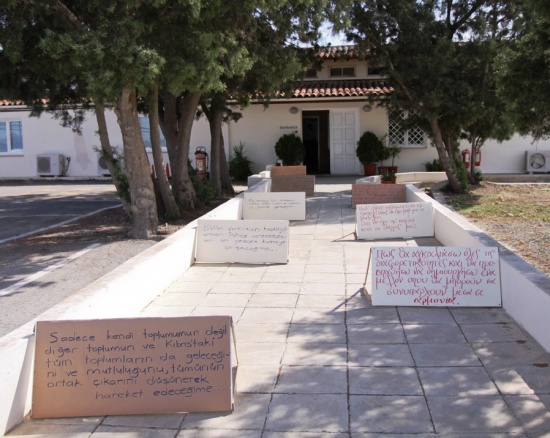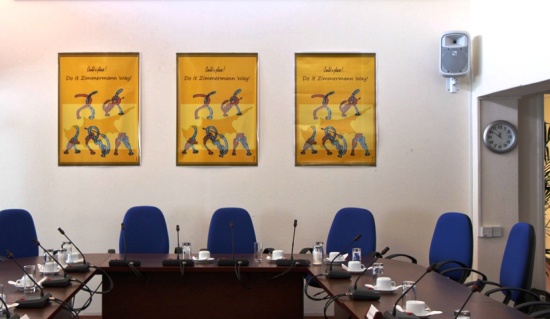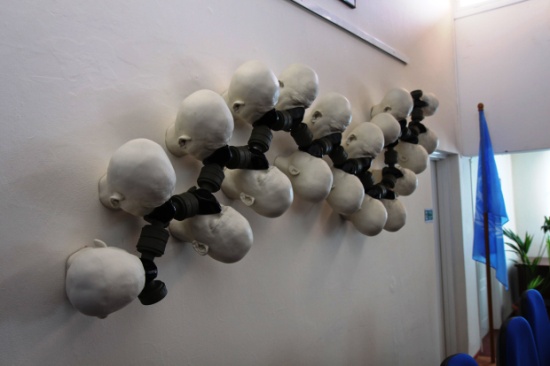


Heidi Trautmann
98 - UN and art in support of Peace Talks : photos
10.11.2009
This report No. 98 is in continuation of No.91. Now I have received a good selection of photos. Unfortunately, we normal people are not allowed in to see it.
Some of the work I recognize. Please read the individual comments to the pictures. given hereunder.
Heidi
I repeat here the names of the artists:
Argyro Tomazou, one of the exhibition’s organizers, said: “The works on display are the creation of seven distinguished Cypriot artists, in a variety of disciplines. Ashik Mene, Kyriakos Kallis, Nilgun Guney, Chara Savvidou, Evgenia Vasiloude and Ruzen Atakan are displaying pieces of sculpture, painting, printing, and in situ installations. The themes touch on interdependence in the island, the asphyxiation of the division and multiple identities imposed, the courage and will required to tie up the solution into a safe knot, a picket line protest for creative negotiations, and nature awaiting unification and regeneration. In addition, the poet Nese Yasin, one of the initiators of the whole project, who met originally with both the leaders back in January, puts forward a poem, a common oath for the negotiating table, attempting to commit both leaders to a genuine exchange of trust, respect, heart and courage, like surgeons bound by the Hippocratic oath, for the success of the peace talks.
UN ART-EXHIBITION
LIST OF ART-WORKS AS EXHIBITED 21/10/09
Conference Hall 1
Kyriakos Kallis «Ars aenigma est», 2007 part of sculptural installation, polyester & fiberglass
«Split up, the ‘self’ multiplies; it becomes the ‘selves’ which adjoin each other. They are connected through the masque of need gagged, just to gasp breath from each other. The green military chaki and the asphyxiating masques symbolize the schizophrenic situation which the green line creates in the psyche and identity of Cypriots.»
Chara Savvidou Untitled, 2009, installation, mixed technique with 6 pickets
«The six pickets, standing on the floor, facing the two leaders in the specific space, compose
the work itself as an installation. As an allegory of a similar situation, where political
leaders are confronted with demonstrators with pickets in their hands, putting out slogans.
The slogan doesn’t function only as a mediator of demands, but, in s strange way, it
replaces the human being, which loses its identity behind the flat discourse of confrontation
used in politics. As the individual disappears behind a collective reality, at the same time we wonder how virtual can this reality be.
The paintings come to replace this absence with a multi-dimensional presence. The presence of art here acts as a proposal of a more substantial communication, beyond sterile rationalism. “The work of art is not a slogan, it’s a vision, a poetry”. This is a reminder for more creative approaches to reality, where there are no rigid positions, oppositions and obsolete rationales.»
Ashik Mene «Untitled », 2009, Print on paper
«In order to have an effective negotiation process and to reach to a strong final solution, it is necessary to have all Cypriots believe in and want this. A sustainable solution itself is only possible through constructive cooperation.»
Nilgun Guney « Republic of Hantekemandre», 2008, Installation, mixed Media
«This installation takes up the problem of identity. The artist, having obtained five different identities herself due to the turbulent recent history of her native land Cyprus, reflects in this particular work the visible dimension of the question ‘Who am I?’ along with an ironic approach to internal conflicts that stem from social conditions.
In an imaginary land, new identities are distributed to people. Some characters, accentuated to represent the public, are somehow ignored, undermined, and excluded by the majority. The artist highlights these ‘other’ed characters, in the ID cards of whom, a personal history remains unrevealed. The stories of these characters are narrated in the manner of a novel, ironically treating them as elements of fiction.
The work portrays a rebellion to humanity (actually to oneself), which is yet the source of various conflicts and pain, causing eventually its own destruction. »
Conference Hall 2
Ruzen Atakan «Without Faces», 2009, oil on canvas, 200x180 cm
«The two communities in Cyprus are living in such a separation that is bound to end with unification. An uncertain future; will they unite? Will they get separated? Are we at fight now? Is there going to be a fight? Are we at peace at the moment or are we going to a have peaceful solution? The politicians are the ones who are having their societies live these circumstances. During each new process, we have new actors come to the stage but its only deadlocks that they do present. That’s because the new actors do not have faces. Even though they physically appear and have names they all look alike. Just like the players who want to win the game. They cannot create a difference to overcome this deadlock. Being different is what’s going to carry our societies to peace. I , Ruzen Atakan, as an artist will not remember any of the faces (portraits) in these peace process as long as they do not make any difference.
Evgenia Vasiloude «Hymn to Demeter - ... come blessed and pure one, and laden with the fruits of
summer, bring peace together with the welcome rule of law ...», 2005
Engravings’ installation with silkscreen prints on canvas and PVC transparencies, A pair of silk screens 70x100cm on canvas and transparency
«Borders don’t just negate the regularity and evolution in the lives of humans. They also hinder nature in a similar way to develop and grow fruit. As peoples’ bonds are lost, their ties with nature are simultaneously lost too. The restitution of all lost bonds will redeem nature and its inhabitant.
I propose this engravings’ installation here, to convey my wish for this nature and these meetings, in this space, to bear real fruit again.
This is how I want to think of Mesaoria plain when I see her now ….»
Nese Yasin «THE OATH FOR THE NEGOTIATING TABLE», 2009, poetry
«People who are elected or nominated to special positions are asked to make an oath. Presidents, Members of Parliaments swear an oath before they start their term of office. This oath is necessary because with their decisions they are responsible for the well being and life of millions of people. Doctors also take the Hippocratic Oath because our lives are in their hands.
The Negotiating Table can be seen as the Operating Table for Cyprus where the island is lying critically injured, cut in two pieces and bleeding. The two leaders are like the doctors who are responsible for the life of this patient. They are also responsible for our lives and well being.
We are living in one of the most heavily militarized places in the world where five armies are present. We give guns into the hands of young people, put them in army camps loaded with ammunition at an age when they are not experienced enough to deal with the pressures and hardships of life.
The Negotiating Table is the table where we are expecting a decision about our fate. It is the most important location in the country at the moment. We can expect both, a sunrise or a sunset from this location.
These considerations formed the basis of my work. I placed the different items of the Oath on the road where the two leaders walk towards the negotiating table, so that it will be the first thing in their minds before they begin talking about the life and well being of the people. I specially chose hand writing to stress the ‘human element’ of the process and to remind them that they are not mechanical tools of politics and diplomacy, but also fragile human beings who have to put their hearts and emotions into their decisions.
They will have the Oath in front of them in Turkish and Greek as a scroll and as a poster in English on the wall to be signed. »
Entrance Ηall
Nilgun Guney «Nicosia», 2004, Acrylic on canvas and collage
Rouzen Atakan « A Bit of Courage », 2009, mixed Media
« A Bit of Courage »
ARTISTS’ BIOGRAPHICAL NOTES
Nese Yasin
Neşe Yaşın was born in 1959 in Cyprus. She is a poet well known and read on both sides of divided Cyprus. She studied Sociology at Middle East Technical University in Ankara. She directed and presented a literary program called “41st Room” at CYBC radio (1992-2007) and the program Peace Garden (2001-2003) at radio ASTRA.
She is currently teaching language and literature at the Turkish Studies department of University of Cyprus, writing weekly columns for BirGün newspaper (Turkey) and Yenidüzen newspaper (Cyprus).
She has published six volumes of poetry ‘Hyacinth and Narcissus’ (1979), ‘Tears of Wars’ (1980), ‘Doors’ (1992), ‘The Moon is Made of Love’ (2000), ‘Chambers of Memory’ (2005), ‘Selected poems’ (2008) and one novel‚ ‘Secret History of Sad Girls’ (2002). Her poetry has been translated to 20 languages, published in literary magazines and anthologies. She has participated in poetry festivals and readings around the world. Among others she has received the Anthias Pierides Award in 1998.
Kyriakos Kallis
Born in Dhali, Cyprus in 1960. Graduated from the Academy of Fine Arts of Prague(1982-1988), on a state-scholarship, specializing on sculpture. Since 1990 he has participated in various solo and group exhibitions, sculptural symposiums and collectiveart- programs and presentations in Cyprus, Greece, London, Germany, Czech Republic, Italy and France. He is a Member of the Executive Committee of the Cyprus Chamber of Fine Arts(2006-09), and part of the art group ‘Noise of Coincidence’ with contemporary action. With the work “Ars aenigma est” he participated in the International Exhibition of Sculptures and Installations “OPEN 10” in Lido-Venice (2007), and more recently in UNSECO Paris.
He teaches fine arts in state schools in Cyprus.
Evgenia Vasiloude
Evgenia Vasiloude is an engraver, born in Pera Orinis, Cyprus. Graduated the State School of Fine Arts in Kiev, Ukraine, a Master in Fine Arts degree (1981-88), specialising in Engraving and Graphic Arts. Since 1992, she has shown her work in four solo shows, and she has participated in group exhibitions in Cyprus. She has also taken part in biennials and other engraving exhibitions abroad, including, Slovenia, Croatia, Greece, Switzerland, England, France, Russia, Spain and Sweden. Recently she took part in the group presentation of Cypriot engravers, “Nicosia-Portland Project”, in the state of Oregon in the USA. Her work, “Hymn to Demeter”, won the second jury prize at the 9th Cairo International Biennial, in 2003. Her works are found in the State Collection of Contemporary Cypriot Art, in bank collections, as well as in private ones. Thematically and conceptually, her work originally focused on the female figure, embodied with references to mythology, especially, the goddess of nature and of fertility. More recently, she deals with issues on nature, the environment and women’s identity.
She teaches fine and graphic arts in state schools in Cyprus since 1989.
Asık Mene
Aşık Mene was born in Larnaca, Cyprus in 1955; the artist started his studies at the Istanbul State Academy of Fine Arts in 1973. He graduated from the Neşet Günal atelier of the Academy, in 1982 and returned to North Cyprus. 1988-2008 His work has been seen in numerous solo and participated exhibitions in Istanbul, Nicosia and abroad. He currently works as a freelance artist and as an art director.
Ruzen Atakan
Ruzen Atakan was born in 1966. She got her BA degree in Fine Arts in 1988 from Gazi University – Ankara. She participated in a number of group exhibitions as well as having several numbers of solo exhibitions both in Cyprus and abroad. She also won numerous awards. Currently, she is an art teacher at Nicosia Fine Art School.
For Two consecutive years Ruzen Atakan organized “Arabahmet Event” in order to promote Arabahmet quarter (1998-2000). The former inhabitants of the quarter such as “Mr. Altıparmak” were invited and gave a talk on the old times of the quarter. A documentary film on Mr Becerikli was also projected. Several exhibitions, workshops and discussions were held during the event.
Nilgun Güney
Nilgün Güney as born in Nicosia, Cyprus 1952. She graduated from Graphic Arts Department of the State Fine Arts Academy with an MA degree 1976. 1991-1998 She worked as secondary level state art school Teacher of Art, she was
Art and Culture Adviser for İktisat Bank for four years. She is also the founder of Founder of European-Mediterranean Arts Association (EMAA). She participated in several solo and group exhibitions and holds numerous awards.
Chara Saavidou
Born in Cyprus. Sculptress.
Neshe Yashin's Oath for the Negotiating Table
I will bear in mind that every time I sit at this table thousands of lives outside are waiting for me, that I hold the fate of children, young people, those older and even that of the unborn in my hands.
That I will not forget the pain suffered by this country over so many years, the fight between brothers, those forcefully torn away from their homes who longed for the other half of their country over many years.
That I will remember the sorrowful faces of women who lost their sons
as I remember my mother’s face and that I will work hard so that not even one son of this country will take up arms and kill another son.
I will include the women of my country in the peace process whose bodies were used without mercy and who suffered the worst of pain throughout the armed conflicts and benefit from their intelligence and sensitivities.
That I will openly present my fears, concerns and longings and will try to understand the fears and concerns of my opposite.
That I will do all I can for the interest of all communities in Cyprus and not just of my own community and for their future and happiness.
That before I object to what my opposite says I will try and understand the situation he finds himself in and his difficulties and will make every effort to find the common ground which will benefit all of Cyprus.
That I will not succumb to the threats of those who do not want to see this country united.
That I will try and do what is best for Cyprus during the most critical moments using my creativity and courage.
That I will propose trust instead of suspicion, hope instead of concern, sharing instead of nationalism.
That I will go beyond the borders of my thinking so that the seas will be the borders of this small island.
That I will set an example to the whole country by the understanding and fraternity I demonstrate at this table.
That I will perceive this table not as a boxing ring where I attempt to defeat my opposite but as a table of friendship where peace in our common country will be established.
That I will regard my opposite not as my opponent but the child of our common mother, Cyprus, and as my sibling sharing the same house.
That whenever I sit at this table I will bring with me my intelligence as well as my heart and my courage
That I will not adhere to the negotiating tactics of the past and will always keep the big picture in mind
That I will not allow any external powers or any internal political calculations to influence me and that I will keep my vision on the long term and not the short term future of my country.
That in place of intransigence and non-compromise I will put generosity and magnanimity
That I will review the positions I am intransigent on and will find creative options in order to reach an agreement with my opposite
That I will not sacrifice the future of our children and grandchildren for the sake of the short term interests of today.
That I will embrace all diversity and try and build a future where they can exist in harmony
That I will not leave this table without ensuring the reunification of our country and securing a future without conflict .
I pledge with all my heart that I will successfully complete this task of extraordinary importance.
http://www.heiditrautmann.com/category.aspx?CID=3325831342


























